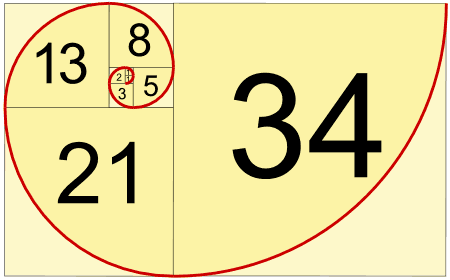A Fibonacci Roulette System is any system that uses the Fibonacci sequence. The sequence is a string of numbers, where the next number in the sequence is the sum of the last two. For example, the first number is 1, and it evolves as: 1,1,2,3,5,8,13 etc. But does the Fibonacci system work? First let’s have a closer look at what the Fibonacci sequence actually is.
The Origin of The Fibonacci Roulette System

The sequence comes from patterns found in nature. Gamblers use the Fibonacci sequence in their systems because they assume nature has the answer to beat roulette. They’re right in a sense, but they don’t understand what the Fibonacci sequence really is, so they use it the wrong way. Consequently their system loses.
Shown here is a graphical representation of the sequence. The proportion of the length of each rectangle corresponds to the golden ratio (1.618). This ratio or number is secret in ancient civilizations. Exactly why is beyond the scope of this article, and the relationship to nature is quite complicated, yet at the time elegant simplicity considering our universe is built on the principle.
One thing you can easily see is the red spiral. You see this spiral everywhere in nature; from the shell of the snail, to the spiral in flowers. You can also see the golden ratio everywhere in nature – even in the proportions of every part of our bodies. A simple example if the lengths of bone between knuckles in our fingers.
Ok so now you have at least a vague understanding of the sequence.
How Does the Fibonacci Relate To Gambling?
The truth is everything relates to the golden ratio and fibonacci in some way. Once you better understand it, you see that physical reality can’t exist without it. But that’s like saying 1 plus 1 wouldn’t equal 2 without mathematics. Perhaps let’s not get philosophical here. The important part to understand is Fibonacci roulette systems are nothing more than betting progression systems. They do not at all increase the accuracy of predictions, so they only vary the size of bets on each spin.
Example Of Fibonacci System
The sequence can be used in many different ways, but the most common is a betting progression like below:
- The player bets 1 unit on red, but loses.
- The next bet is 1 unit again, and the player loses
- The next bet is 2 units, and the player loses
- The next bet is 3 units, and the player loses
- The next bet is 5 units, and the player wins.
From point 5, the player can either go back to step 4, or back to step 1.
Does The Strategy Actually Work?
No. In the example above, the player is simple betting different amounts on completely independent spins. The odds of red and black spinning next are exactly the same at each point. There is not even an effort to consider why red would spin more frequently than black, which is a common fault of roulette strategies.
There is an exception where a Fibonacci betting sequence would actually help the player profit more in less time, as explained below:
The Only System Where a Fibonacci Roulette Strategy Works
Advantage play roulette strategies like roulette computers or roulette wheel bias analysis scientifically predict where the ball will fall. Such approaches are the only ones that work, and they give the edge back to the player. A typical edge can be as high as 90% or more for a roulette computer. In such cases, the player will profit even if their bet size was the same on each spin. But it’s possible to still have losing streaks, where the player may not win for perhaps 5 spins in a row. There is no way to avoid losing streaks because you can never perfectly predict the winning number.
If the Fibonacci betting system was applied in such a cases, the player has a strong edge and is almost guaranteed to win in the next few spins. This means the bet size can safely be increased, and more can be won in less time.
The betting strategy doesn’t necessarily need to be the Fibonacci sequence. It could just as easily be the Martingale where bet size is doubled after each loss. But it is wiser to use a less aggressive progression because if your strategy is too aggressive, you can lose a lot in a short time all because of uncanny bad luck. The Martingale bet sequence is 1,2,4,8,16,32 and you can see the size of bets quickly spiral out of control. A milder progression (bet size after losses) may be 1,2,3,4,5,6 and so on.
Should You Use The Fibonacci Sequence In Roulette?
There is no reason why the Fibonacci sequence is any better then another betting progression. You simply increase bets after losses, but does not change the odds of winning at all. Even the circumstances I explained with advantage play, doesn’t actually change odds of winning. This simply increases the amount you win in a specific time period, but this is only you have an advantage to begin with. Some players who swear by the Fibonacci sequence really have no understanding of how to really win at roulette. There are many systems for sale they use the Fibonacci sequence, and the sales material touts the system uses patterns from nature. Certainly a lot can be learned from nature, and in fact my own systems use principles that are discovered in nature, but it has nothing to do with the betting sequence.
To get the best free roulette systems that really work, see the top 5 proven roulette systems and the video series below. It's the best 100% free information for winning roulette you'll find. It's written by professionals who are really earning a living from roulette. |
